So you know exactly what to expect
It’s been just over a month since Samsung released the much-anticipated Galaxy Note 10 phones and the initial excitement has had time to cool in the glare of cold reality. Since Apple launched their iPhone 11 series at the same time, general smartphone hysteria is still at a fever pitch, but a month living with the latest, greatest smartphone is still enough to dull the edge of pure hype.
The phone we used during this 30-day period is a 256GB Aurora Black Samsung Galaxy Note 10+. It is however not the US model using a Snapdragon system-on-a-chip. Instead, this is the version using Samsung’s in-house Exynos 9825 SoC. The difference between these two chips is essentially imperceptible.
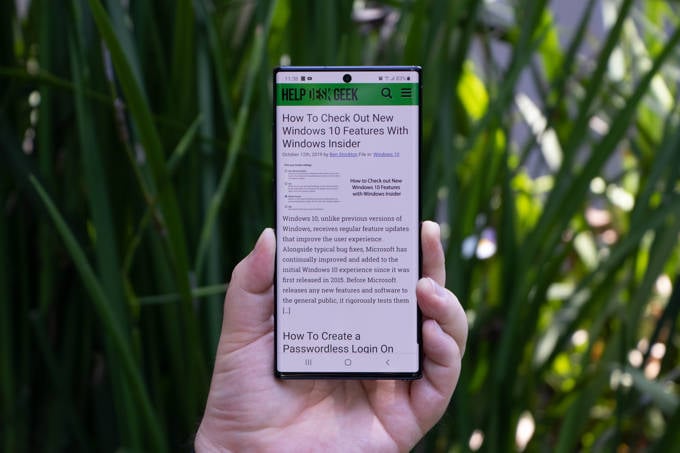
If you have a Note 10+, you have one of the fastest phones in the world and the margins between the top contenders are hardly enough to influence your buying decisions, unless you only care about synthetic benchmarks.
So the first thing you need to know about our time with the Note 10+ is that performance was never once an issue. If something runs poorly on this phone, it will run poorly on any contemporary smartphone. With that small point crossed off the list, we can dig into the real-world experience of using the Note 10+.
What We Got In The Galaxy Note 10+ Box
If you’ve bought a modern Galaxy phone since Samsung decided to embrace USB Type C, then you’ll know that quite a few bits and bobs were included in the box to help ease the transition.
You’d get an OTG adapter to connect USB A devices to your phone, as well as a Micro-USB to Type C adapter and a USB A to USB C cable. Sadly none of these rather useful accessories were included with the flagship Note 10+. Inside the rather attractive box you’ll find one pair of AKG “tuned” USB-C earphones, one USB-C to USB-C cable and a wall charger that takes USB-C exclusively.
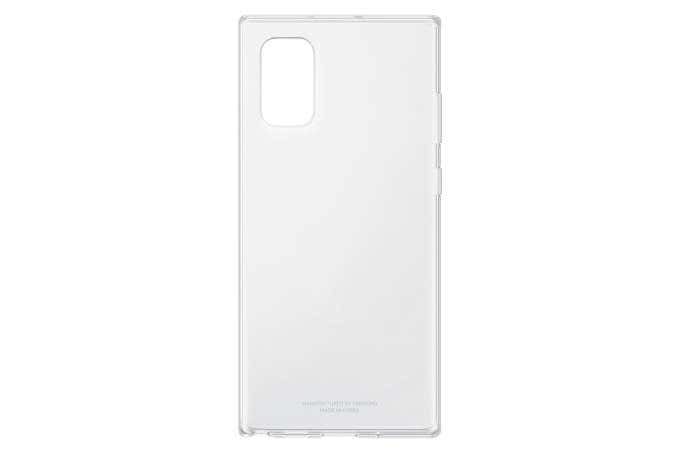
One problem immediately presents itself here. If you want to connect your Note 10+ to any device that doesn’t feature a USB-C port, you’ll have to go out and buy a Type C to Type A cable or cannibalize it from another device. It’s especially weird since one of the unique flagship features, dockless Dex support, needs a USB cable connection to a PC and you’ll rarely find USB-C connectors on PCs that aren’t relatively new. Even then, it’s still not a standard, widespread feature.
A very welcome inclusion is the factory-fitted screen protector and included silicon cover. Both of these are basic but very serviceable. The clear silicon cover does hide the rear finish of course, but if you are going to make use of a cover, it’s best to wait until your phone arrives to see if you like it.
Silicon covers for the Galaxy Note 10+ aren’t cheap and if you’re happy with the bundled one it would make more sense to put that money towards a Samsung Care plan.
The failure to include a 3.5mm to USB-C adapter is however inexcusable in a phone of this caliber and price. It’s a small additional cost, but there’s no way the typical Note 10+ user isn’t going to need a way to connect an auxiliary 3.5mm audio cable to their phone at some point. Adding the cost of such an adapter would surely not have moved the needle on profitability.
Aesthetics & Build Quality
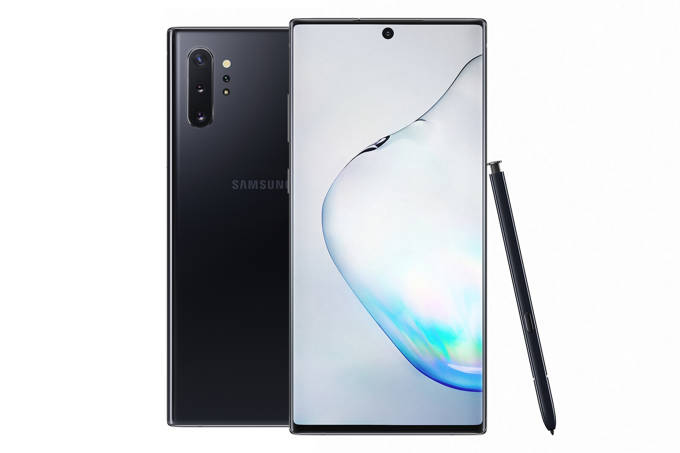
Starting with the S8, Samsung really has been upping its design game and flexing its tech muscles. The last few generations of Galaxy flagships have developed a distinctive, futuristic design that really feels too advanced for 2019, compared to what else is available.
The now-signature double curved screen has creeped even closer to the edges of the device, almost completely eliminating the bezel. More than 90% of the front of this phone is screen and that’s a revelation.
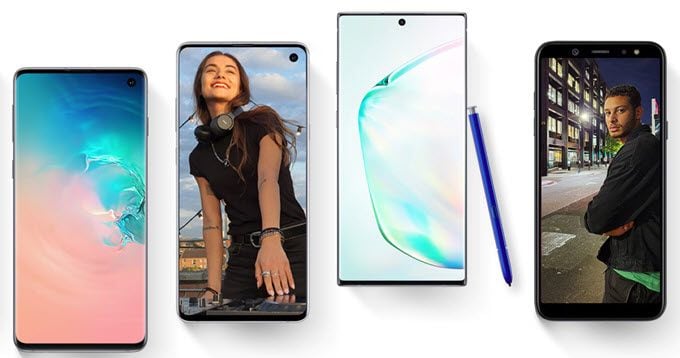
Of course, this leaves the issue of where to put the front-facing camera, but barring some sort of future under-screen camera technology or a motorized pop-up solution, it’s hard to imagine how the designers at Samsung could have made this less obtrusive. The front camera has been reduced to a single, tiny hole punch that very quickly becomes invisible during daily use.
It’s fairly simple to toggle apps between full-screen and normal mode. So if you can’t abide the hole punch in certain apps, you can simply restrict the edges of the app to stop short of crossing into that zone.
Ergonomics
How well specified a phone is doesn’t matter much if it’s a literal pain to use. Make no mistake, the Note 10+ is massive. Operating it with one hand isn’t impossible, but it takes some doing. By using all four fingers to lift and move the phone, you can just about reach every corner of the screen.
YouTube URL: https://youtu.be/aFtDcW-Kk7M
Samsung is aware of this and has had a “one-handed mode” in their note phones for a while now. It’s not activated by default and it does make using the phone with one hand as easy as using a smaller phone, by dynamically altering the display and user interface as you use it.
We didn’t feel the need to activate this feature, but users with smaller than average hands will surely be glad the option is there. If you are curious, this mode isn’t hidden too deeply.
Simply open Settings and head to Advanced Features > Motions and gestures > One-handed Mode.
The Under-Screen Fingerprint Reader
One of the worst casualties of the screen ratio wars has been the fingerprint reader. Facial recognition and the very wonky “iris scanning” that debuted with the S8 just don’t work as well as a traditional fingerprint scanner.
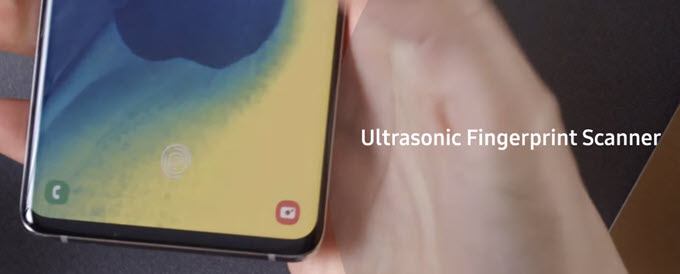
However, moving the fingerprint reader to the back of the phone causes all sorts of usability issues. If the phone is in a car mount, unlocking it is a pain and you have to resort to a passcode or pattern. If the phone is laying on its back, you have to pick it up to unlock it or, once again, fall back to the passcode.
YouTube URL: https://youtu.be/lYtdxDedCLM
So everyone will be overjoyed to hear that the under-screen fingerprint reader works flawlessly. It’s fast and, once you learn where it is located, pretty easy to use. Samsung has an OS-level overlay that pops up whenever an app asks for fingerprint authentication. Everywhere we tested it worked as advertised. Whether it was web-based authentication for Paypal or in our banking app, it just worked.
While some have complained that under-screen readers are noticeably slower than the traditional kind, this was never an issue. Regardless, Samsung released an update that included speed improvements for the reader about halfway through the month. While we are happy to believe it’s faster now, it seems just as snappy.
The Camera(s)
It’s basically impossible to find a flagship smartphone, or even a mid-range model, that has what any person could call a “bad” camera. Differences in camera performance between the top dogs these days often come down to subjective preference or subtle technical differences that make no difference to the average consumer.
The Galaxy Note 10+ does not have the best cameras on a phone today, by various measures. However, it’s hard to imagine anyone being unimpressed with what is clearly a serious push by Samsung to make this an incredible all-round content creation machine.
There are three rear-facing cameras on the phone, from super-wide to telephoto. The easiest way to demonstrate what you get is to show you. Here are some head-to-head photos with the Note 9, with the exception of the new ultrawide lens of course.

This first image is the result of the Note 10 Plus ultra-wide angle lens, which the Note 9 lacks.
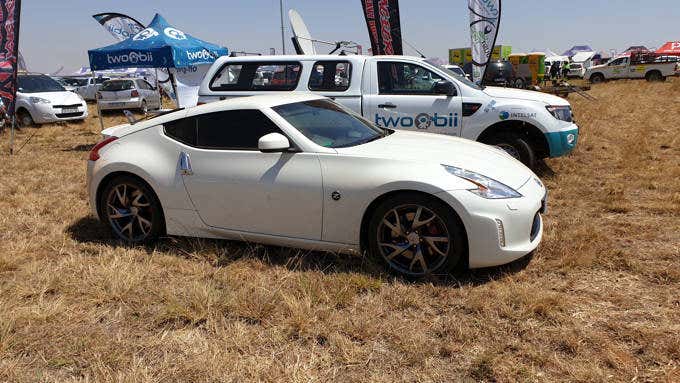
This is the Note 9’s standard wide-angle lens.

Here we can compare the results, since this is the Galaxy Note 10+ standard wide angle lens.
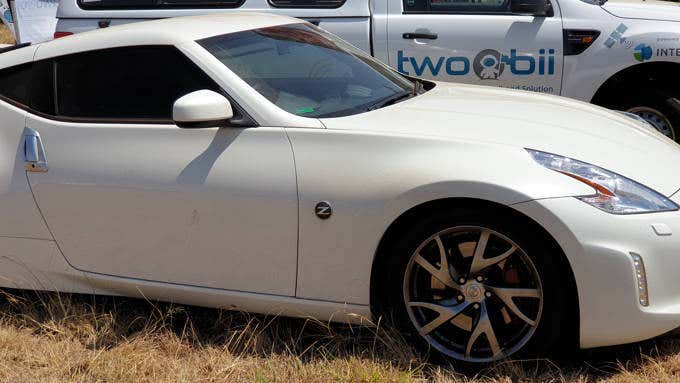
The Note 9’s telephoto lens was a welcome addition and it still looks pretty darn good.

Video is also a pretty important aspect of modern premium smartphones. So we decided to head over to the local off-road motorcycle racing track and put the Note 10+ through its paces.
First, here’s a clip using the ultra-wide angle lens and “super stabilization”. Of course, YouTube does do a little damage to the visuals with its compression, but it remains a level playing field since this happens to all videos uploaded to the web.
YouTube URL: https://youtu.be/sMQkjq9wQAY
For an action sports event, what you really want is slow-mo, and here the Note 10+ really impressed with its standard slow motion setting.
YouTube URL: https://www.youtube.com/watch?v=OLPEapciQZs
As you can see, the Note 10 Plus is a step up from the phone it replaces, but you have to look at the photos side-by-side, as if the Note 9 takes poor photos. The inclusion of the ultra wide lens is however a pretty big deal if you are a serious phone photographer. It’s one killer feature that justifies upgrading from the previous generation Note.
Everything here was shot on full-auto, as most people are likely to use the phone. However, the built-in camera app includes plenty of manual options for those who want to achieve near-professional results.
Dockless Dex!
Samsung Dex is a desktop environment that’s been built into their phones since the S8’s release. By using the Dex Station accessory, you could connect a screen, mouse and keyboard to your phone. Docking the device takes you straight to Dex where you can do virtually everything you could with a regular light productivity machine.
The Dex stations were rather pricey, although these days you can pick them up for a fraction of the launch price. Still it doesn’t seem that this has caught on with users, so Samsung has done something new with Dex for the Note 10 release.
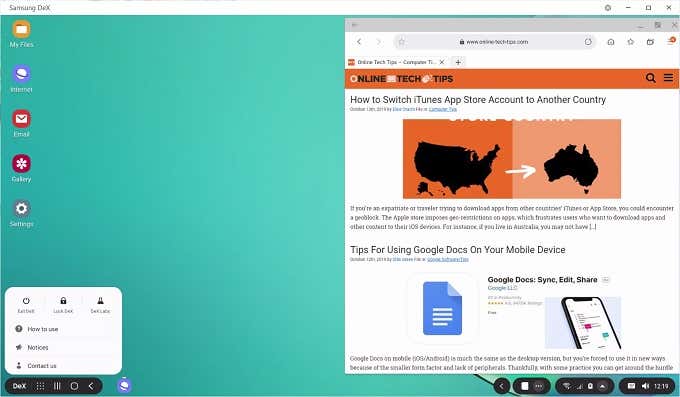
You can use Dex with a Windows or Mac by installing the Dex app on it. Then when you connect the phone to the computer via USB, Dex opens up as a desktop app.
Now, it’s fair to ask what the point of this is when you’re already sitting at a computer. But there are quite a few use cases where this form of Dex makes sense. Internet cafes or other public computers are one example. You can also use Dex on your work computer to ensure none of your personal information gets mixed in with company data.
Dex is a neat app and worked pretty well. There was certainly some detectable lag, but nothing that rendered the application unusable. Most importantly, Dex makes it dead easy to transfer data between a computer and your phone and the Note 10 is powerful enough that normal phone operations keep working as usual, even while Dex is running.
The Stylus
No review of a Galaxy Note device is complete without looking at the actual “Note” bits of the product.
The bottom line is that writing on this screen feels eerily like writing on paper with a pen. Side-by-side with our Note 9, the experience is pretty much the same. The Note 10+ feels perhaps a tiny bit more responsive, but not that you’d notice day-to-day. The new stylus has a much longer battery (technically a supercapacitor) life. The Note 9 will last 30 minutes before needing a recharge.

The new stylus will keep trucking for more than 10 hours, which we did not test. Simply because there’s no reasonable scenario where you’d use the stylus for that long without putting it back into the phone. You don’t need to pay attention to the battery life anymore.
YouTube URL: https://youtu.be/ZaXp-0Y-tVs
Which is good, because the stylus can now perform remote control functionality. Using it with the PowerPoint app and as a remote camera trigger is awesome. However, the app has to specifically support it. Some macro-like customization would have been nice.
This is the best stylus experience on any phone. If you like to doodle, write notes, mark up PDFs or do lots of presentations on the go, it’s brilliant. If you don’t care about this aspect of the Note10+, you’re much better off saving some money and getting a Galaxy S10+.
Real World Battery Performance
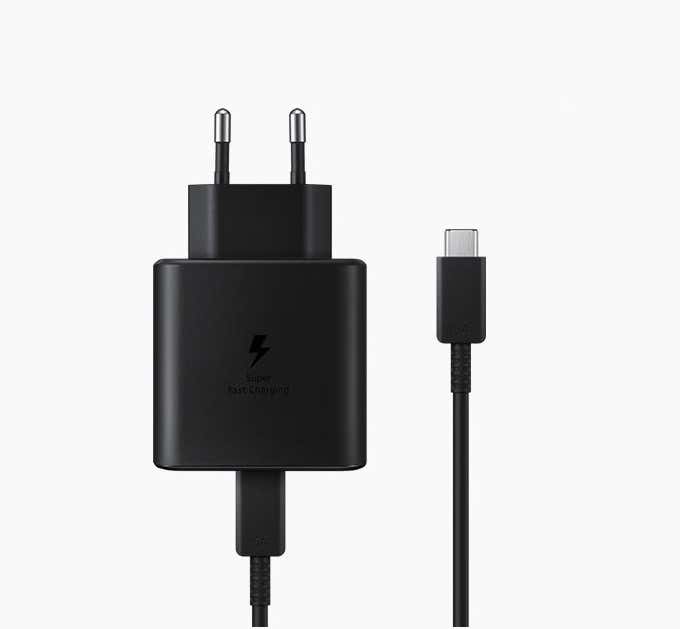
The Note 10+ has an absolutely massive 4300 mAh battery and you’ll find various reviewers around the web subjecting it to torture tests that empty the phone out at a little less than 12 hours of abuse.
While that’s an interesting metric on its own merits, most people would rather like to know what sort of performance they can expect on average, day-to-day. After using the Note 10+ for a month, we can definitively say that unless you plan to be away from any sort of charging facility for more than 24 hours, battery life isn’t something you need to spend any time thinking about.
We made a point of starting the day off with a full charge and only putting the phone back on charge at bedtime. Usage during the day included general web browsing, YouTube Music, moderate amounts of gaming and more Netflix than is strictly recommended. When at home or in the office, the phone was set to use WiFi, with about two hours of LTE use during commutes each day of the week.
For the most part, after a full work day, the Note 10+ still had at least 40% left in the tank. We’re sure very heavy users might get closer to that 12-hour torture test mark in real life, but the vast majority of users should have no issues.
For the sake of interest, going to bed with a full charge and leaving the phone unplugged overnight typically used about 8% of the total capacity. The Note 10+ does of course learn your usage patterns and adapts to them to optimize battery use, but we saw great battery performance out of the box.
However, let’s say you do manage to drain the phone into the red – what about charging time? In a word – woosh! The included wall-charger rapidly fills the meter back up. Going from 60% to 100% takes 40 minutes. Bear in mind that you can buy a faster 45W charger, but we’re sticking to what you get for the asking price.
Who Should Buy a Note 10+?
You’ll notice that there isn’t much in the way of negative sentiment when it comes to the Note 10+. While it’s not a perfect device, it does represent a sort of premium smartphone pinnacle. It’s not the best at any one thing, but the device has no real weaknesses either. Whatever you want to do with the Note 10+, it will comply without complaint and gives a generally flawless performance.
The biggest problems relate to its size. We strongly recommend holding one of these phones in your actual hands before buying one. It’s no larger than the Note 9 to hold, but anyone else not accustomed to this relative bulk need to try before they buy.
The physically smaller Note 10 may be a better all-round choice and if you don’t want the stylus functionality we strongly recommend you consider the Galaxy S10 and S10+ instead.

Which brings up the next most important issue – Note 9 owners. If you have a Note 9, the Note 10 doesn’t bring enough to the table to warrant an upgrade. If it is your natural time to upgrade then you’ll definitely feel happy with your new phone. There are no backwards steps here. But don’t cut your time with the Note 9 short for this phone. The cost simply isn’t justified.
If you are considering buying a Note phone for the first time, there has never been a better time to get onboard. Make no mistake, the Note 10+ is the true Note.
The big, no-compromise phone that has the best specifications when it launched and is aimed at enthusiast users. Which is the main point, the Note 10+ is an enthusiast-class device. It is more than anyone needs, but exactly what many of us want.
Samsung has reached the summit of this particular mountain and that shows in what’s on the horizon. The Galaxy Fold may now be the next cutting-edge tech-geek phone and there are strong rumors that the Galaxy S10 and Note 10 phones will be the last of their respective lines.
Instead they will be merged into a new hybrid device. If true, this is the masterpiece capstone of a legendary smartphone line and it’s undoubtedly a great one.
